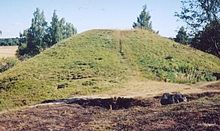Ottarshögen
The Ottarshögen is a burial mound in the north of the Swedish province of Uppland . It comes from the final phase of the Germanic Iron Age (375-550 AD) and is one of the largest burial mounds in Sweden with a diameter of 37 meters and a height of over five meters. It is located south of Husby in the municipality of Tierp , directly on a road. The mound is part of a grave field of about 60 graves from Vendel on the southern edge of Husby, which was used for several hundred years.
Large mounds with a diameter of more than 30 meters are often called Kungshögen in Sweden ( German "Königshügel" - Sättuna Kungshög ; Kungshögen Högsäter and Nysäter; Kungshögen (Höllviken) and the Kungshögarna of Malmö-Oxie ). They are mainly found around the Mälaren , some examples can also be found in other landscapes. The large mounds often date from the younger Iron Age . Some of the biggest: Anundshög in Västmanland , Grönehög in Bohuslän , Högom in Medelpad , Inglinge hög in Smaland , Kung Ranes hög in Vastergotland, Ledbergs kulle in Östergötland , Randens hög in Halland , Skalunda hög in Vastergotland , Ströbo hög in Västmanland and the three Hills in Old Uppsala in Uppland.
Popular belief holds the Ottarshögen for the grave of in Beowulf called mythological King Ottar (Ohtere) Vendelskråka , a king from the Ynglingergeschlecht . The rich animal ornamentation (animal style) on the weapons and jewelry that the archaeologist Sune Lindqvist found during the excavations carried out in 1914 and 1916 belongs to the Vendel style .
Web links
- Ottarshögen - entry in the database "Fornsök" des Riksantikvarieämbetet (Swedish)
- Ottarshögen - Description of the Riksantikvarieämbetet (Swedish)
Coordinates: 60 ° 8 ′ 29.5 ″ N , 17 ° 34 ′ 31.7 ″ E
